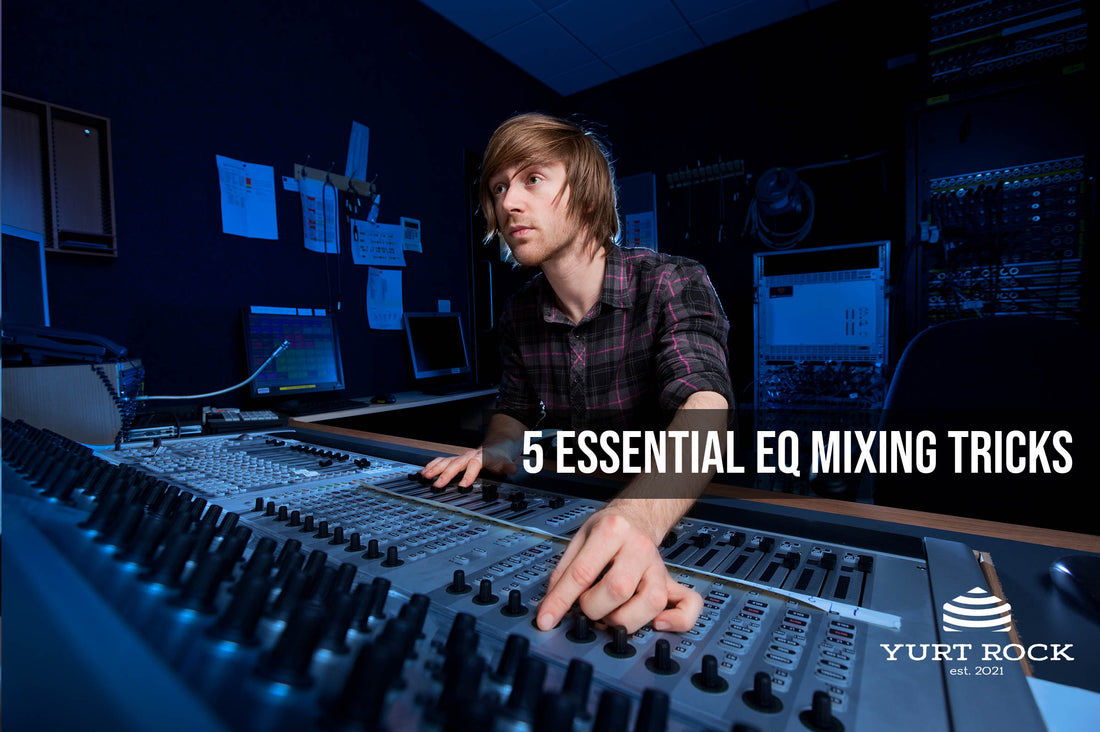In today's blog post, we'll uncover five essential EQ mixing tricks that these professionals employ to create chart-topping tracks. Get ready to elevate your mixing skills with these expert techniques!
1. Surgical Frequency Carving with Parametric EQ
One of the most fundamental EQ techniques used by renowned engineers is surgical frequency carving with parametric EQ. This involves using a parametric equalizer to target specific problem frequencies or enhance desired elements in the audio. Engineers often refer to this as "notching out" unwanted frequencies or "boosting" to emphasize certain instruments or vocals.

Suggested Gear:
- FabFilter Pro-Q3: Known for its precise controls and transparent sound, making it a favorite for surgical EQ adjustments.
- Waves Renaissance EQ: This classic plugin provides a wide range of frequency manipulation options and is favored by many top engineers.
Frequencies:
- Notching out resonant frequencies: Commonly around 200-500 Hz to reduce muddiness or boxiness in instruments.
- Vocal clarity: Boosting presence frequencies between 2 kHz to 6 kHz to bring vocals to the forefront of the mix.
2. Using High-Pass and Low-Pass Filters
High-pass and low-pass filters are simple yet powerful tools that can dramatically clean up your mix and add clarity. High-pass filters cut out unwanted low-frequency rumble, while low-pass filters can remove harsh high-frequency noise or excessive sibilance.

Suggested Gear:
- Universal Audio API 550A: This classic hardware EQ includes effective high-pass and low-pass filters that impart a distinct character to the audio.
- Ableton EQ Eight: A versatile plugin offering excellent filtering options, perfect for digital productions.
Frequencies:
- High-Pass Filter: Typically set around 20-100 Hz to remove unnecessary low-end rumble from instruments like guitars, vocals, and synths.
- Low-Pass Filter: Set around 10 kHz to 18 kHz to soften overly bright sounds or cymbals that may cause listener fatigue.
3. Boosting and Cutting Competing Instruments
In a mix, certain instruments may clash and compete for sonic space, leading to a muddy or cluttered sound. To resolve this, skilled engineers employ EQ to boost specific frequencies in one instrument while simultaneously cutting the same frequencies in another.

Suggested Gear:
- SSL G-Series EQ: This legendary hardware EQ has been used on countless hit records and is renowned for its musicality and ease of use.
- Izotope Neutron: An intelligent plugin that can analyze audio and suggest specific EQ adjustments to avoid frequency conflicts.
Frequencies:
- Boost: For a lead guitar to stand out, a gentle boost around 2 kHz can add presence while reducing the same frequency in rhythm guitars to avoid masking.
- Cut: When mixing a dense arrangement, cutting around 500-800 Hz in the piano can create space for the vocals to shine.
4. Subtractive EQ for Taming Resonant Frequencies
Recording in less-than-perfect environments can lead to resonant frequencies that color the sound and become distracting. Renowned engineers employ subtractive EQ to tame these resonances and regain control over the mix.

Suggested Gear:
- Maag Audio EQ4: Known for its unique "Air Band" that can add a silky high-end sheen or be used to cut harsh resonances.
- Waves SSL E-Channel: Modeled after the iconic SSL 4000 console, this plugin offers precise control for subtractive EQ tasks.
Frequencies:
- Subtractive EQ: Identify and reduce resonant frequencies by making narrow cuts of 3-6 dB in the range of 300 Hz to 800 Hz.
5. The Art of Mid-Side EQ
Mid-Side EQ is an advanced technique that allows engineers to treat the mono and stereo elements of a mix independently. By applying EQ exclusively to the mid or side signal, the mix can achieve greater clarity and width.

Suggested Gear:
- Brainworx bx_digital V3: This powerful plugin provides a comprehensive mid-side EQ processing with an intuitive interface.
- Weiss DS1-MK3: An industry-standard hardware processor that can perform mid-side EQ and dynamic processing.
Frequencies:
- Mid EQ: Enhance vocals and center elements by adding warmth in the lower mids (200 Hz to 800 Hz).
- Side EQ: Widen the mix by gently boosting the high frequencies (10 kHz to 18 kHz) in the side signal.
These five essential EQ mixing tricks used by famous recording engineers and mixers are your gateway to achieving professional-sounding mixes. Remember, it's not just about the gear; it's about the art of using EQ to sculpt your audio and create a cohesive and captivating musical experience. Happy mixing!
Disclaimer: The gear mentioned in this blog represents popular choices among recording engineers but doesn't imply any specific endorsement or affiliation.

